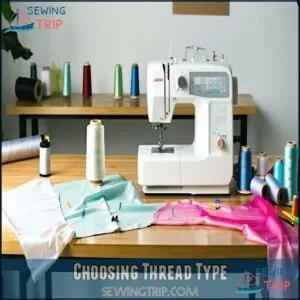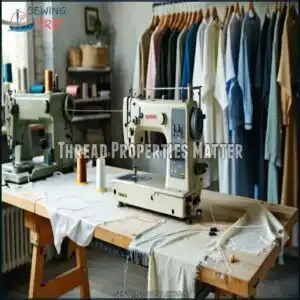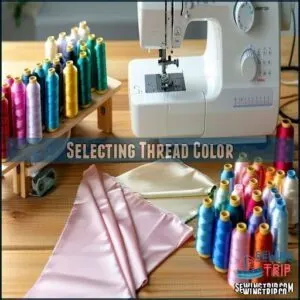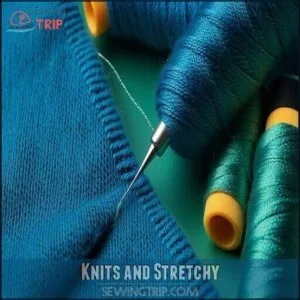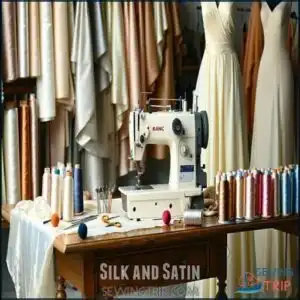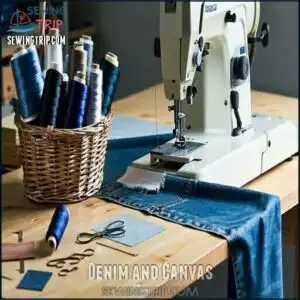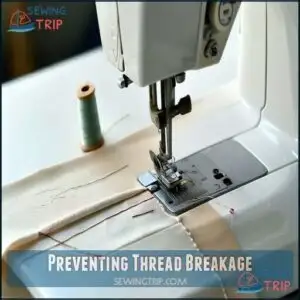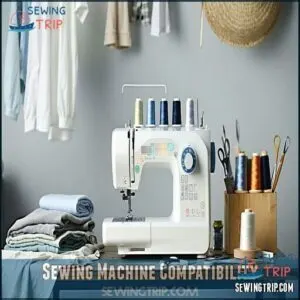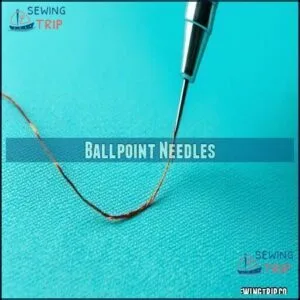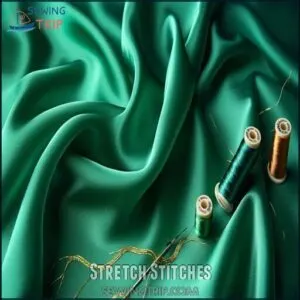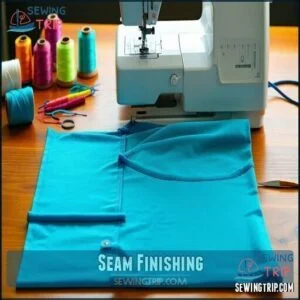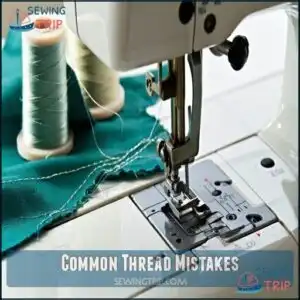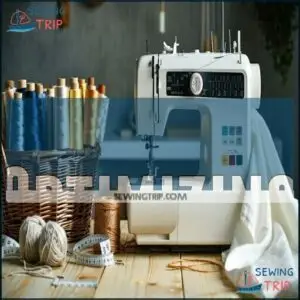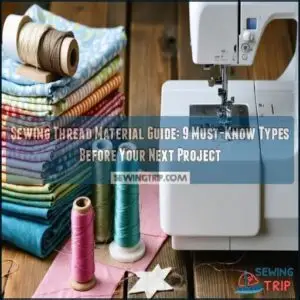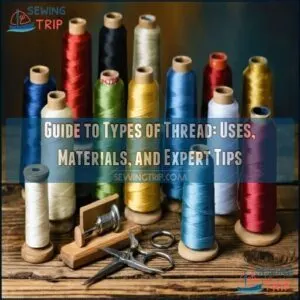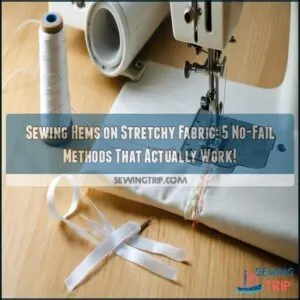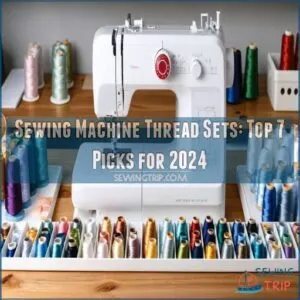This site is supported by our readers. We may earn a commission, at no cost to you, if you purchase through links.
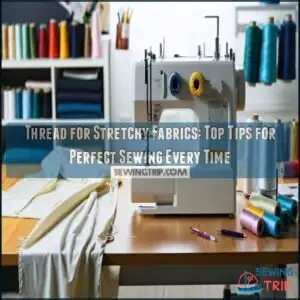
Avoid cotton thread—no stretch, no forgiveness! For extra elasticity, try elastic thread, but only in the bobbin, and hand-wind it to prevent tangling.
Your stitches also need to stretch, so pair that thread with a stretch stitch or zigzag setting on your machine.
For smooth seams, grab a ballpoint needle—it glides through fabric without snagging.
Remember, the right combination of thread and technique is like the perfect dance partner for your fabric. Ready to take the next step?
Table Of Contents
Key Takeaways
- Use polyester thread for stretchy fabrics because it’s strong, flexible, and won’t snap under stress.
- Always pair your thread with a zigzag or stretch stitch to maintain the fabric’s elasticity.
- A ballpoint needle prevents snags by gliding through stretchy fabrics without damaging them.
- For extra stretch, wind elastic thread by hand into the bobbin and test stitches on scraps before sewing.
Choosing Thread Type
Choosing the right thread type for stretchy fabrics guarantees your seams can stretch without breaking.
The right thread for stretchy fabrics keeps seams strong, flexible, and ready to move with your garment.
You’ll want to focus on synthetic options like polyester, which offer strength and flexibility for your projects.
Natural Fibers
When choosing thread for knit and stretchy fabric, natural fibers like cotton offer breathability but lack the thread stretch needed for flexibility.
Cotton types vary, but untreated options support sustainable textiles and eco benefits, especially with natural dyes.
However, their limited stretch makes them less ideal for fabric stretch requirements, so reserve them for applications where durability outweighs elasticity.
Synthetic Fibers
Synthetic fibers are a game-changer for stretchy fabric.
Synthetic threads like polyester and nylon bring flexibility and durability, making them perfect for sewing stretchy fabrics effortlessly.
Polyester thread is strong and a little flexible, ideal for seams needing both durability and give. Nylon thread, another man-made fiber, shines in high-stretch projects thanks to its elastic properties.
Fiber blends often offer versatility, combining strength and stretch.
- Polyester threads: Durable with slight stretch.
- Nylon threads: High elasticity.
- Elastic thread: Perfect for gathering and shirring.
Thread Weight
When matching thread to fabric weight, think of it as pairing shoes to an outfit—it must fit.
Heavier fabrics like denim need thicker threads (lower gauge), while lightweight knits work best with finer options.
Thread thickness should complement fabric density for smooth sewing.
Balance thread gauge and material choice to guarantee durability and flexibility, especially when tackling stretchy fabrics.
Thread Properties Matter
The right thread properties, like strength and stretch, are essential for ensuring smooth seams and long-lasting garments.
Choosing a thread with proper breathability and absorbency also helps your fabric move and perform as intended.
Breathability
Breathability matters when sewing stretchy fabrics.
Threads need to support air circulation and sweat evaporation while accommodating stretch.
Using the right sewing needle types is essential for stretch fabrics.
Consider these tips:
- Use synthetic fibers like PTT for moisture wicking.
- Match thread strength to the fabric weave.
- Opt for stretch fabric thread to maintain body temperature.
- Choose lighter threads for better airflow without compromising seam durability.
Absorbency
Absorbency matters, especially with moisture-wicking fabrics or sweat-heavy projects.
Threads with a low absorbency rate, like synthetic fibers, resist water retention, making them ideal for stretchy textiles.
Natural fibers, while breathable, absorb moisture more easily, which can lead to slower drying speeds.
Pair thread types to your fabric’s needs—synthetics thrive in activewear, while cotton’s sweat absorption works for casual knits.
Understanding thread production methods is essential for selecting the right thread for your project, considering the importance of absorbency.
Strength
Absorbency is one thing, but strength is where thread shines for stretch fabrics.
You want sewing thread that resists breakage while keeping stitches secure.
Here’s what to watch for:
- Choose high tensile strength threads for long-term durability.
- Opt for polyester thread—it’s reliable for seam durability.
- Test knot security with PTT.
- Always prioritize stitch integrity over aesthetics.
Selecting Thread Color
Choosing the right thread color for stretchy fabrics guarantees your seams blend smoothly or make a bold statement. Focus on complementary or harmonious colors to achieve the best visual effect.
Color Psychology
Understanding color psychology helps elevate sewing projects.
Thread color influences mood and style. Think about fabric types and Palette Choices when making your decision.
Use this table for guidance:
This information can help you make informed decisions about color contrast and tone matching to achieve the desired saturation effects in your sewing projects.
Complementary Colors
Choosing complementary colors for your thread can add vibrant contrast to stretchy fabrics.
Think of using opposing hues on the color wheel—like blue and orange—to achieve striking color harmony.
Contrast effects can highlight details or accents, while careful hue selection guarantees balance.
Consider palette choices and tint variations that complement fabric elasticity, facilitating smooth color matching while enhancing your project’s overall appeal.
Harmonious Colors
When aiming for harmonious colors, think of thread and fabric as partners in a duet.
A well-considered palette selection—matching thread color with fabric hues—avoids glaring contrasts.
Opt for subtle tint variations or hues from the same family to create unity.
Good color harmony complements your fabric selection, ensuring the thread blends seamlessly.
Precise hue matching elevates the project’s visual appeal.
Thread for Specific Fabrics
When sewing stretchy fabrics, using the right thread guarantees smooth, flexible seams that won’t snap under stress.
Polyester thread, with its slight stretch and durability, is your go-to choice for most knit and elastic materials, and is a key factor in creating smooth, flexible seams that can withstand the demands of stretchy fabrics.
Knits and Stretchy
Stretchy textile projects like knit fabric need the right thread to stay comfy and durable. Aim for polyester or elastic threads—they’re strong and flexible.
Follow these sewing tips:
- Use stretchy stitches for stable stretch seams.
- Pair ballpoint needles with knit fabric thread.
- Prevent fabric curl by using stabilizers.
- Skip cotton—it’s not stretch-friendly.
When working with stretch fabrics, consider using stretch sewing techniques to achieve professional results.
Silk and Satin
Silk and satin bring elegance but demand delicate handling.
For smooth sewing, use a lightweight thread like polyester or silk. Choosing the right thread types for sewing is essential for project success. Elastic thread works for slight stretch.
Pair with fine needles and adjust tension. Avoid pulling the fabric while sewing to preserve its drape. Mastering silk weaving and satin finishing takes care and patience.
Fabric Thread Type Needle Key Tip
Denim and Canvas
Denim and canvas demand strength. Use heavy-duty thread matched to denim weights for durability, especially during seam reinforcement and topstitching techniques.
A stretch needle works well for stretch-denim blends, preventing skipped stitches. Canvas needs thicker needles for seamless sewing, so adjust accordingly.
Choose threads that won’t snap under pressure, ensuring every stitch holds. Strong tools make tough fabrics cooperate effortlessly, with durability being key to a successful project.
Preventing Thread Breakage
To prevent thread breakage when sewing stretchy fabrics, focus on proper thread tension and machine settings.
Stabilize the fabric if needed to guarantee smooth stitching and reduce stress on the thread.
Thread Tension
Thread tension is key to sewing stretchy fabrics without headaches.
Start with a standard setting like 4 or 5, then fine-tune for balance. Loose stitches? Tighten it. Puckering? Loosen it slightly.
Proper tension control guarantees stitch regulation and sewing elasticity. Adjust needle tension gradually, testing on scraps.
Remember, thread tension adjustment is vital for maintaining fabric stretch and preventing breakage, which is crucial for sewing stretchy fabrics.
Sewing Machine Settings
Adjusting your sewing machine settings is key for smooth stitching on stretchy fabrics.
Use a stretch stitch or zigzag stitch type to support the fabric’s flexibility. Choose a ballpoint needle to avoid snags, and reduce presser foot pressure to prevent pulling.
Align thread tension carefully for consistent results, and make certain feed dogs evenly handle the fabric for perfect sewing machine compatibility.
Fabric Stabilization
To master fabric stabilization for stretchy fabrics, try fabric interfacing on tricky sections, or use edge stabilizers like pattern weights for secure cutting.
Ironing techniques help smooth out curls—press the fabric’s backside to avoid damage.
Reinforce seams with stretch textile thread or elastic sewing thread for flexibility.
These stabilization techniques guarantee professional results without unnecessary stretching or puckering.
Using the right stabilization methods is vital for achieving a perfect fit and preventing fabric distortion.
Sewing Machine Compatibility
You’ll need to make certain your sewing machine is compatible with the threads and fabrics you’re using.
Choosing the right needle, thread weight, and presser foot is essential for smooth stitching on stretchy fabrics.
Thread Weight and Type
Finding the right thread weight and type is key for stretchy fabric sewing.
Lightweight knits need finer threads, while heavier materials require thicker ones. Polyester thread works best for most elastic sewing threads due to its strength and flexibility.
Understanding thread weight measurement is essential for selecting the appropriate thread for your project.
- Choose fiber blends like polyester-wrapped thread for stretch.
- Adjust thread thickness to match fabric density.
- Ensure material strength for durable seams.
Needle Selection
Picking the right needle is key when sewing stretchy fabrics.
Ballpoint needles prevent snags, while stretch needles handle elastic-heavy materials.
Twin needles provide strong, flexible seams.
Needle size matters too—use smaller ones for lightweight fabrics and larger ones for thicker knits.
Nail your needle selection using this quick guide:
When working with stretchy materials, using the right stretch fabric needles is essential for achieving professional results.
Presser Foot Choice
When sewing stretchy fabrics, the presser foot you choose can make or break your project.
A walking foot or dual feed attachment helps move fabric evenly, preventing shifting. Adjust foot pressure for smooth stitching or use edge stabilizers for slippery materials.
Fabric guides are handy with zigzag or stretch stitches, supported by feed dogs and a stretch needle.
- Walking foot: Even fabric feeding
- Dual feed attachment: Prevent slipping
- Edge stabilizers: Control fabric curling
- Adjustable foot pressure: Avoid puckering
Stretch Fabric Thread Tips
Using the right thread for stretchy fabrics guarantees your seams stay strong and flexible.
Pair quality polyester or woolly nylon thread with a ballpoint needle to prevent skipped stitches and fabric damage.
Ballpoint Needles
When sewing stretchy fabrics, a ballpoint needle (also called a stretch needle) is your best friend.
Its rounded tip glides between fibers instead of piercing them, reducing fabric damage. You can find a variety of ballpoint needles for sale for this purpose.
Proper needle selection guarantees smooth stitching and prevents skipped stitches.
For thread compatibility, pair with elastic thread for flexibility. Regularly check needle maintenance to avoid dull tips ruining sewing techniques.
Stretch Stitches
When sewing stretchy fabrics, stretch stitches keep seams flexible and durable.
Choose a stretch stitch that suits your fabric’s elasticity and weight.
Follow these tips:
- Use a zigzag or lightning bolt stretch stitch for great Elastic Recovery.
- Maintain even Fabric Tension.
- Adjust Stitch Length for Seam Stability.
- Test stitches first on scraps to ensure Seam Stability.
Seam Finishing
Perfectly finishing seams on stretchy fabrics prevents unraveling and keeps the garment durable. Use seam binding or fabric stabilizers to avoid puckering. Folded hems work well for stretchy edges, and stretch stitches provide flexibility.
Consider interfacing tips for extra stability on delicate areas. Stretch hemming is essential—don’t skip it!
Below, find seam-finishing techniques based on fabric needs:
Common Thread Mistakes
Using the wrong thread for stretchy fabrics can lead to weak seams, puckering, or even tearing.
Make sure you understand common mistakes like using threads with insufficient stretch, mismatched tension, or incompatible materials to avoid frustrating setbacks, including weak seams.
Insufficient Stretch
Insufficient stretch in seams creates headaches like thread breakage or puckering seams.
Stretchy fabrics need the right stitch for flexibility.
Straight stitches often fail under stretch.
Instead:
- Use a zig-zag stitch for elastic textiles.
- Pick a triple stitch for areas handling strain.
Verify proper seam allowance and thread tension to avoid fabric bunching while maintaining the stretch percentage needed.
Incompatible Thread
Using the wrong thread for stretch fabrics causes thread breakage, fiber damage, and needle snags.
Cotton threads lack stretch, leading to fabric tears and tension issues. Always choose polyester or specialty stretch thread types to guarantee fabric compatibility.
Thread for stretch fabrics needs elasticity; without it, seams won’t hold up.
Proper thread compatibility avoids common sewing headaches.
Incorrect Tension
If the thread was breaking earlier, it’s time to check your needle tension. Incorrect tension can ruin sewing stretchy fabric.
Watch for fabric puckering or thread breakage as warning signs. Here’s a quick fix guide:
- Adjust tension settings for elastic fabric thread.
- Test stretch stitches on scraps.
- Slow your sewing speed.
- Match needle tension to fabric weight.
This guide provides a simple approach to resolving common issues with sewing stretchy fabric, focusing on the importance of proper tension settings.
Optimizing
Optimizing your sewing setup for stretchy fabrics isn’t as tricky as it seems. Start by focusing on thread selection—stick to polyester or elastic fabric thread for flexibility and durability.
Proper fabric prep is vital; pre-washing and stabilizing with starch or interfacing can improve fabric performance and prevent stretching mishaps. Mastering sewing techniques like using a ballpoint needle and gradually adjusting tension helps guarantee smooth seams.
For stretch optimization, test your stretch stitches on fabric scraps to avoid surprises mid-project. Remember, stretchy fabrics need thread and stitches that move with the fabric.
Fine-tuning your tools and methods gives you full control, turning sewing stretchy materials into a satisfying experience rather than a frustrating task. Don’t skip these details—they matter!
Frequently Asked Questions (FAQs)
What thread is best for stretchy fabric?
Polyester thread is your best bet for stretchy fabrics.
It’s strong, slightly elastic, and pairs perfectly with stretch stitches.
For extra flexibility, try woolly nylon in the bobbin—it’s a game changer for durable seams.
What kind of stitch do I use for stretchy fabric?
You’ll want to use a zigzag stitch or a stretch stitch for stretchy fabric.
These stitches provide flexibility and prevent seams from snapping.
Test settings on scraps to find the perfect tension and width.
Is there a trick to sewing stretchy fabric?
Imagine smooth sailing on fabric seas—your trick lies in using a ballpoint needle, stretch stitch, and steady hands.
Reduce presser foot pressure, test stitch tension on scraps, and sew slowly for perfect results, with steady hands.
What do you line stretch fabric with?
Line stretch fabric with lightweight, stretchy materials like power mesh for added support or tricot for a smooth finish.
These linings enhance structure without restricting movement, making your garment flexible and comfortable.
Conclusion
Mastering stretchy fabric sewing can feel like taming a wild beast, but the right thread makes all the difference.
Always choose polyester thread for its strength and flexibility, and pair it with a stretch stitch for seamless results.
Don’t forget a ballpoint needle to prevent snags and elastic thread in the bobbin for extra give.
With the proper setup and technique, you’ll conquer every project with ease, and remember, thread for stretchy fabrics is your sewing superpower!
- https://www.amazon.com/stretch-thread-sewing-fabric/s?k=stretch+thread+for+sewing+stretch+fabric
- https://www.reddit.com/r/sewing/comments/lnmch9/what_kind_of_thread_do_you_use_for_activerwear_or/
- https://sewcanshe.com/how-to-sew-stretch-fabrics/
- https://sewing.patternreview.com/SewingDiscussions/topic/126707
- https://www.sewcanshe.com/blog/double-needle-sewing-machine

